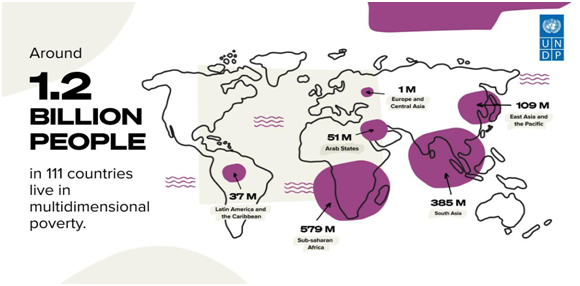

Context
The recently released Global Multidimensional Poverty Index (MPI) indicates that 41.5 crore people exited poverty in India during the 15-year period between 2005-06 and 2019-21.
Key Highlights of the Index: (India-specific Data)
- It shows that the incidence of poverty fell from 55.1% in 2005-06 to 16.4% in 2019-21 in the country.
- The deprivations in all 10 MPI indicators saw significant reductions as a result of which the MPI value and incidence of poverty more than halved.
- About 41.5 crore people exited poverty in India during the 15-year period between 2005-06 and 2019-21, out of which two-thirds exited in the first 10 years, and one-third in the next five years.
- Improvement in MPI for India has significantly contributed to the decline in poverty in South Asia.
- It is for the first time that it is not the South Asian region with the highest number of poor people, at 38.5 crores, compared with 57.9 crores in Sub-Saharan Africa.
- The report doesn’t fully assess the effects of the COVID-19 pandemic on poverty in India as 71% of the data from the National Family Health Survey-5 (2019-2021) relied upon for MPI were collected before the pandemic.
- Bihar is the poorest State in 2015-2016, seeing the fastest reduction in MPI value in absolute terms. The incidence of poverty there fell from 77.4% in 2005-2006 to 34.7% in 2019-2021. India’s present scenario:

- India has by far the largest number of poor people worldwide at 22.8 crores, followed by Nigeria at 9.6 crores.
- Two-thirds of these people live in a household in which at least one person is deprived of nutrition.
- There were also 9.7 crore poor children in India in 2019-2021.
- About 4.2% of the population in the country still lives in severe poverty.
- Rural areas account for nearly 90% of poor people.
|
The Global Multidimensional Poverty Index:
|
How we can measure poverty?
- Poverty can be defined as a condition in which an individual or household lacks the financial resources to afford a basic minimum standard of living.
- Economists and policymakers estimate “absolute” poverty as the shortfall in consumption expenditure from a threshold called the “poverty line”.
- The official poverty line is the expenditure incurred to obtain the goods in a “poverty line basket” (PLB).
- Poverty can be measured in terms of the number of people living below this line (with the incidence of poverty expressed as the head count ratio). The “depth” of poverty indicates how far the poor are below the poverty line.
- Six official committees have so far estimated the number of people living in poverty in India
- The working group of 1962
- V N Dandekar and N Rath in 1971
- Y K Alagh in 1979
- D T Lakdawala in 1993
- Suresh Tendulkar in 2009
- C Rangarajan in 2014
- The government did not take a call on the report of the Rangarajan Committee; therefore, poverty is measured using the Tendulkar poverty line.
- As per this, 21.9% of people in India live below the poverty line.
How poverty impacts India’s economy?
- Less number of people getting resources.
- Growth inclination as rich becomes richer and poor becomes poorer
- Low income generation
- Drop in standard of living conditions
- Cheap labour and man-power available
- Gender inequality
- Low rate of education


